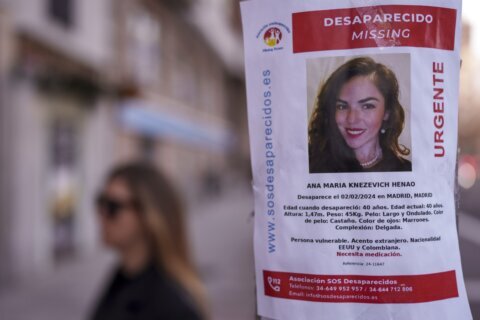NEW YORK (AP) — It’s the stuff of movies: Two friends vow to marry each other if they’re not hitched by a specified future date or age.
Well, the Marriage Pact, an annual matching ritual that has become popular on nearly 90 college campuses around the U.S., has turned that dusty cliche into fun.
And a few couples have found lasting love.
Nearly half a million students have participated since the pact first rolled out at Stanford University in 2017. Born of an economics project by two students there, the pact involves an algorithm that rates matches based on such statements as “I prefer politically incorrect humor” and “I pride myself on telling hard truths.”
Unlike dating apps and services, each student gets just one name, a percentage on the quality of the match and an email address to reach out.
“The idea is, if you think about everybody who goes to your college, surely there’s someone who is a good backup plan for you,” said Liam McGregor, one of the students who came up with the pact. “Not a Prince Charming, you know, not your perfect person necessarily, but maybe somebody whose number you should have.”
The questions, he said, “are selected based on, hey, what do we need to know to have a 50-year relationship with someone? Can we make it a great one?”
WHO SIGNS UP FOR THE MARRIAGE PACT?
Many students do it with friends just for fun and don’t follow up. Others are ghosted after trying to make contact. A tiny fraction land in long-term relationships, even marriage.
Count Max Walker and Melia Summers in that last group. The two were New York University students when they did the pact in fall 2020. It was just a lark for both. He was in New York and she was at NYU’s Abu Dhabi campus. They chatted online for months, then Summers took a semester to study in New York.
Their first physical date, for pizza, was nearly a year after their match. Wedding bells will ring June 29. The quality of the match, according to the algorithm, was 99.65%
Take that, Tinder.
“We liked the same music. We did the same sports. We’re both from rural places,” Summers said. “It was kind of funny, right? It’s someone saying that they can find your, like, ultimate match. I didn’t really know if I was ready for my ultimate match at the time but I thought that was kind of a funny promise. And also, my friends were doing it, and we thought it’d be kind of interesting to do it together.”
The two plan to move to Knoxville, Tennessee, after the wedding so Walker can attend law school there.
HOW THE MARRIAGE PACT BEGAN
McGregor, who runs the pact, said it spread quickly after word got out. Students from 15 other schools tried in the beginning to get in on the Stanford pact because it wasn’t available on their campuses. That’s not allowed. A campus-specific email address is required.
Rather than dwell on physical beauty and personal stats like height and hair color, he said, the Marriage Pact focuses its 50-question survey on core values. Communication styles and conflict resolution. Smoking and drug habits. And things like: “If you do nothing for an entire day, how do you feel?” On a 1 to 7 scale, “like a lard” is 1 and “like royalty” is 7.
The University of Michigan marriage pact poses this puzzler: “There is a place for revenge when someone has wronged me.” On the 1-7 scale, 1 is “turn the other cheek” and 7 is “plotting rn.” The Boston College pact wants to know: “I would end a friendship over differing political views,” and the Notre Dame questionnaire queries: “I would send older relatives to a nursing home.”
Questions are tailored for each campus since values may vary among students. At Georgetown, questions about politics and ambition are included, for example, whereas the Stanford pact may ask about things like careerism and spontaneity.
Pandemic restrictions kicked in as the pact spread wide to new campuses. “It was just harder to date,” said Katie Richards, who did the pact at Boston College in February 2021.
Richards, now 25, was matched with Miguel Corzo, also 25. Both were seniors. After some time dating long distance after graduation, they now live together in Philadelphia and just marked their third anniversary. He got down on one knee and proposed during the recent eclipse’s totality in Erie, Pennsylvania, offering a diamond ring just as the moon left a glowing ring around the sun.
“We just did the Marriage Pact because our friends did it. We were just like, oh, you know, why not? It’s something to do while everyone’s locked away,” Corzo said.
NOT EVERY MATCH LEADS TO LOVE
About 30% of matches meet up in person, and 1 in 9 of those end up dating for a year or longer, McGregor said. He knows of several other engaged couples. Some couples who were already dating have participated for fun and wound up matched with each other, he said.
McGregor was stunned at the interest in his little project after receiving the go-ahead from an economics professor.
“We sort of said, hey, could we get 100 people to sign up, because the matches won’t be any good if fewer than 100 people sign up. In the first day, more than 1,000 people signed up, and the next day another 1,000 people signed up. By the end of the week, 60% of everyone at Stanford had signed up to get their optimal marital backup plan,” he said.
Some students do the pact over and over again. It took Paul Armstrong and Shelby Merrill just one try in 2022 at the University of Massachusetts at Amherst. Neither took it that seriously at the beginning.
“All my buddies filled it out,” Armstrong said. “I got a lot luckier than they did.”
Their match hit 99.9%. Armstrong mailed off a personal resume to Merrill with some of his stats, likes and skills, listing among the latter: “Making playlists on Spotify (please don’t have Apple Music).”
“When they sent me his email I was like, I’m not going to email him. This is dumb. But then he sent me that and I was like, OK, he put some effort into it. This is cute,” Merrill said.
The two, who live in separate Massachusetts towns, are planning their first overseas trip together, to Scandinavia. At 24 (Paul) and 23 (Shelby), they’re planning to move in together at some point.
“We’re not in any rush,” Armstrong said.
Copyright © 2024 The Associated Press. All rights reserved. This material may not be published, broadcast, written or redistributed.







